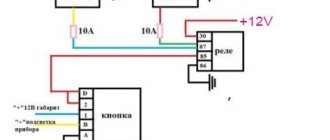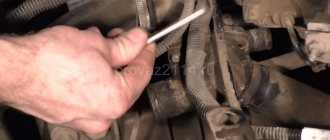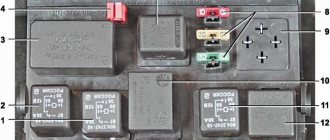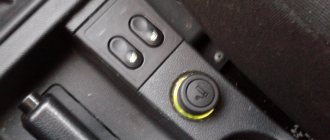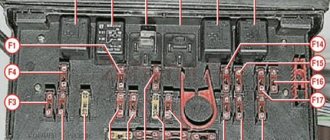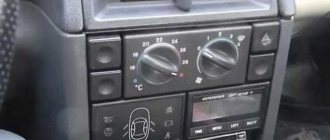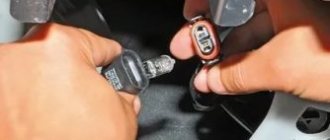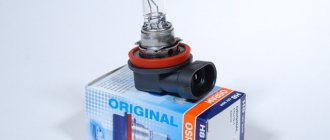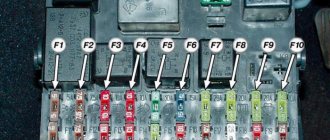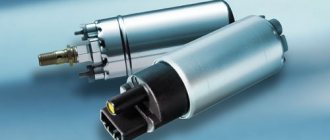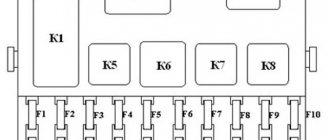Fuse and relay box
The fuse and relay box is located on the left, lower part of the instrument panel. It is accessible by pressing the button and folding the lid down. To remove fuses, there are special non-conductive pliers in the upper left part of the mounting block.
1 - K5 - high beam relay. If the high beams in two headlights do not work, check this relay. If one of the high beam headlights does not work, check fuses F3 and F13, as well as the lamps and the high beam switch.
2 - K4 - low beam relay . If the low beam in both headlights does not work, check this relay. If only one low beam headlight does not work, check fuses F2 and F12, as well as the lamps themselves and the light switch.
3 - K1 - lamp health control relay.
4 - non-conductive tweezers for removing fuses.
5 - power window relay . If your power windows stop working, check this relay. It could also be in fuse F5, or in the window lift drive system itself. To get to the mechanism, you need to remove the door trim. Check the electric motor, the appearance of the gears and the absence of binding of the mechanism.
6 - K3 - turn signal and hazard warning relay . If your turn signals or hazard lights do not work, check this relay and fuse F16, as well as the turn signal lamps themselves and their switch.
7 - starter relay . If the car does not start and the starter does not turn, check this relay. It could also be a dead battery, as well as the starter mechanism itself.
8 - backup fuses.
9 - fog lamp relay . If the fog lights do not work, check this relay and fuses F4 and F14. Also check their connection diagram, the serviceability of the wiring and connectors, as well as the lamps in the headlights and the power button.
10 - K2 - windshield wiper and washer relay . If your windshield wipers or windshield washer are not working, check this relay. Also check the wiper motor, washer pump and washer fluid level in the washer reservoir.
11 - K7 - rear window heating relay . If the heating does not work and the rear window fogs up, check this relay and fuses F8 and F9. Also check the connection contacts to the terminal points of the heating elements (at the edges of the glass at the rear pillars). If everything is in order, but the heating does not work, the issue may be in the wiring (the wires are frayed or something else).
12 - K6 - add. relay, ignition relay . If your ignition does not turn on or is having problems with it, check this relay. This relay protects the ignition switch contacts from burning. Also check the ignition switch itself and the contact group.
13 - row of fuses F1-F1014 - row of fuses F11-F20
How to check the fuse?
New model mounting block VAZ-2113, 2114, 2115. Location of fuses and relays.
Relay Description:
K1–relay for turning on headlight cleaners; K2–relay-interrupter for direction indicators and hazard warning lights; K3 – windshield wiper relay; K4 – lamp health monitoring relay; K5 – power window relay; K6 – relay for turning on sound signals; K7 – rear window heating relay; K8 – headlight high beam relay; K9 – relay for turning on low beam headlights; F1–F20—fuses; X11 – terminals of the wiring harness block Table of circuits protected by fuses on the VAZ 2114
| Fuse number | Current strength, A | Circuits protected by a fuse |
| F1 | 20 | Rear fog lamp switching relay. Rear fog lamp lamps. Rear fog lamp switching indicator |
| F2 | 10 | Direction indicators, relay-interrupter of direction indicators and hazard warning lights (in hazard warning mode) Hazard warning lamp |
| F3 | 7.5 | Front interior lamp. Central interior lamp. Luggage compartment lighting. Illumination lamp for the ignition switch. Lamp for monitoring the engine management system. Brake light bulbs. Trip computer (if installed) |
| F4 | 20 | Socket for connecting a portable lamp. Relay for turning on the heated rear window (contacts). Rear window heating element |
| F5 | 20 | Sound signal. Horn relay. Cooling fan electric motor. Fan fuse. |
| F6 | 30 | Electric windows. Power window relay (contacts) |
| F7 | 30 | Heater electric motor. Heater fuse for VAZ 2114, VAZ 2115. Electric motor for windshield washer. Headlight wiper motors (in operating mode) Cigarette lighter fuse. Glove box lighting lamp. Rear window heating relay (winding) |
| F8 | 7.5 | Fuse for fog lamps VAZ 2114, 2115 - Right fog lamp |
| F9 | 7.5 | Fuse for fog lamps VAZ 2114, 2115 - Left fog lamp |
| F10 | 7.5 | Side light lamps on the left side. Indicator lamp for turning on the side light. License plate lamps. Engine compartment lamp Instrument lighting switch. Fuse for backlight lamps of switches, instruments, cigarette lighter, ashtray, heater control levers |
| F11 | 7,5 | Side light lamps on starboard side |
| F12 | 7,5 | Right headlight (low beam) |
| F13 | 7,5 | Left headlight (low beam) |
| F14 | 7,5 | Left headlight (high beam). High beam indicator lamp |
| F15 | 7,5 | Right headlight (high beam) |
| F16 | 15 | Direction indicators, relay-interrupter for direction indicators and hazard warning lights (in turn indication mode). Reversing lamps. Relay for monitoring the health of lamps. On-board control system display unit. Instrument cluster. Insufficient oil pressure indicator lamp. Parking brake indicator lamp (brake light fuse). Brake fluid level indicator lamp. Low battery indicator lamp. Trip computer (if installed). Generator excitation winding (in engine starting mode). Front windshield wiper. Seat heating control. |
Diagram of the VAZ-2113, 2114, 2115 mounting block Option No. 1.
Relay Description:
K1-relay for turning on headlight cleaners; K2-relay-breaker for direction indicators and hazard warning lights; K3 windshield wiper relay; K4 relay for monitoring lamp health; K5-power window relay; K6-relay for turning on sound signals; K7-relay for turning on the electric heating of the rear window; K8-relay for turning on the high beam headlights; K9 relay for low beam headlights;
Diagram of the VAZ-2113, 2114, 2115 mounting block Option No. 2.
Date added: 07/14/2014
It's no secret that the VAZ 2114 fuse box is the main component of the vehicle's wiring system. This device has a specific circuit and allows you to protect all kinds of car system devices, such as the cigarette lighter, stove, fuel pump and others from malfunctions and overvoltage. In this article we will provide you with basic information regarding the location and replacement of components.
Circuit breakers
Now let's see which fuses are responsible for what in the same mounting block. I will also give the main reasons for troubleshooting.
F1 (5 A) - license plate lighting lamps, dashboard lighting, side lights on the panel, trunk lamp, left side lights . If any of the listed lamps do not work, check this fuse, as well as the lamps themselves and their contacts. If everything is in order, check the headlight switch button.
F2 (7.5 A) - low beam in the left headlight . If both low beam headlights do not work, also check relay K4 and the lamps themselves. It could also be the light switch and its contacts.
F3 (10 A) - high beam in the left headlight . If both high beam headlights do not work, check the K5 relay, the lamps themselves and the high beam switch knob.
F4 (10 A) - front fog lamp on the right side . If both fog lights do not work, check relay 9 and the headlight bulbs themselves, as well as the switch and its contacts.
F5 (30 A) - window lift motors . If the power windows do not work, check this fuse and relay 5. In winter, check if the windows are frozen, warm them up and clear them of ice if necessary. It could also be the window lift motor, its mechanism and gears; in order to get to it, you need to remove the trim of the desired door.
F6 (15 A) - portable lamp fuse.
There may also be problems with the cigarette lighter. To check, unplug the cigarette lighter from the connector. If this fuse stops burning, then the problem is in the cigarette lighter.
F7 (20 A) - engine cooling fan, sound signal . If the cooling fan does not turn on and the engine overheats, check this fuse. Also check the operation of the fan motor by connecting it directly to the battery. It could also be the coolant temperature sensor or thermostat.
F8 (20 A) - heated rear window (element) . If the heating does not work and the rear window fogs up, check this fuse, fuse F9 and relay K7. Also check the contacts on the terminals of the heating elements, check the wiring, sometimes the wire frays. It could also be the heating switch and its contacts.
F9 (20 A) - recirculation valve, windshield wipers and washer, headlight washer, rear window heating relay coil . If the heating does not work, similar to the previous one.
If the windshield wipers or washer do not work, also check relay K2, the fluid level in the washer reservoir, the washer pump, and the wiper motor. Another issue may be their switching handle, its wiring and contacts. The wires may be squashed or frayed and shorted to the housing.
F10 (20 A) - backup fuse. F11 (5 A) - right side dimensions. If the left side does not work, check fuse F1.
If none of the side lights work, check the light switch and its contacts. Also check the dimensions of the lamps themselves.
F12 (7.5 A) - low beam in the right headlight . Similar to fuse F2 for the left headlight.
F13 (10 A) - high beam in the right headlight, high beam lamp on the dashboard . Similar to fuse F3 for the right headlight.
If the blue lamp on the panel does not light up when you turn on the high beams, check this fuse, as well as the lamp itself and the wiring to it. F14 (10 A) - front fog lamp on the left side.
Similar to fuse F4 for the right fog light. F15 (20 A) - seat heating, trunk locking. If the heated seats do not work, check this fuse and the power button on the dashboard, its contacts and wiring.
F16 (10 A) - direction indicators and hazard warning lights, hazard warning lamp . If the turn signals or hazard lights do not work, also check relay K3 and the lamps in the turn signals themselves, as well as the hazard light switch button.
F17 (7.5 A) - interior lighting, lighting, ignition switch lighting, brake lights, clock, on-board computer . If the brake lights do not work, check this fuse, the lamps themselves, and also the switch installed in the pedal unit.
F18 (25 A) - glove box lighting, heater controller, cigarette lighter . If the cigarette lighter does not work, check this fuse, disassemble the cigarette lighter and check for a short circuit in it, especially on the washer and contacts. Bend them if necessary or replace the entire cigarette lighter. Do not insert non-standard size connectors into it.
F19 (10 A) - door locks, control relay for brake lights and parking lights, turn signals and lamps for turning them on on the panel, reverse lamp, generator winding, control indication of the on-board system, dashboard, clock, on-board computer.
F20 (7.5 A) - rear fog lights.
If the rear fog lights do not work, check this fuse and relay 9. Also check the lamps themselves, wiring, connectors and the switch on the panel.
Never replace blown fuses with fuses of a higher rating (current), this can cause burnout of tracks on the mounting block, failure of devices, etc. In this case, repairs will cost more, so it is better to deal with the problem immediately and fix the problem. If you cannot find what’s wrong on your own, contact a car service; usually such problems are dealt with by electricians, who will not have any difficulty identifying the problem and fixing it.
Fuses and relays in Lada Kalina
Fuses and relays Niva Chevrolet.
In case of any problems with car electrical systems, many owners give up and entrust the repairs to specialists. In some cases, indeed, this may be the only way out. But not when the fog lights on the VAZ-2110 do not work. We will try to solve this problem right now.
Both fog lights stopped working
Sometimes it's better to live.
The fog lights stopped lighting along with the tidy. Moreover, the mileage display works. The tidy backlight (brighter - dimmer) also does not work((((Sadness((
I have already burned out 10-15 fuses (((The one under the steering wheel is on. I put it on the more powerful one, it burns out under the hood due to the dimensions.
I turned off the fog lights and the dash lights are still on.
Did you get into the wiring? Additional gavnetol sensors?
No, they didn’t do anything like that. Yesterday during the rain I think it went out, or after it.
Nothing has been installed on the car for “a hundred years.” The fuse for the fog lights is on. Accordingly, the following happens: I start it, turn on the dimensions - everything is ok, well, almost)) the tidy does not work (tidy lights), I turn on the fogs and the fuse blows. Near and far are working!
The fogs seem to be original.
The fuse blows when I turn on the headlights. but the dimensions are on fire. Those. It's not even a matter of fogs. and in the tidy.
Correctly, the fog lights are made through the dimensions precisely through the snout, the fog lamps have their own fuse, and the dimensions have their own relays, and at the moment the dimensions are turned on, when the fuse burns out, are the fog lamps turned on or off? those. — turned on the lights, everything is fine, the fuse for the fog lights works, then you turn on the fog lights, does the fuse burn out? or so - you just turn on the headlights, the fog lights are turned off, and the fog light fuse still burns out?
what about the fuse? which I voiced - which is used to illuminate the tidy and often some other lighting in the cabin.
Many opinions and topics have been voiced on many forums regarding short circuits in the instrument panel (a lot of lyrics.
Unexpected reasons for non-working PTFs on the VAZ-2110
The most common cause is a blown fuse. But we will return to it later. There is still a lot that is still unknown in the design of foglights, relays, switches and lamps. For example, a possible reason for the failure of fog lights could be a completely unexpected breakdown.
First of all, we check the bulbs themselves; you can get to the left one through the hood. On some versions of the VAZ-2110, a PTF from the Avtosvet plant (Kirzhach) was installed with a socket for the H1 lamp. Stock lamps are not the best quality and they do not like sudden changes in temperature.
It is quite difficult to get to the right fog lamp through the hood; it is easier to remove the headlight itself by unscrewing the screws.
During sudden cooling, when leaving the garage in winter, for example, or after turning off the headlights, the contact leg of the lamp bulb simply fell off the conductor . At the same time, visually the halogen lamp looked absolutely intact. It was enough to apply a plus directly to the leg itself, and the lamp would light up. The fault was due to poor-quality resistance welding, and it is almost impossible to detect the cause without a detailed examination of the lamp itself and its dismantling.
Of course, it is impossible to provide for all failure options, but we will consider the most common ones.
One fog light on VAZ-2110 does not light up
There may be plenty of options here. Apart from damage to the lamp itself or its filament, the picture is as follows:
- Fuse . When correctly installing PTF on the ten, as a rule, they use the scheme presented above. F4 or F14, is responsible for the operation of each lamp .
They are located in the mounting block, which is located in the niche of the front panel to the left of the driver. When replacing a fuse, we do not use bugs or jumpers, but only new fuses. Fuse location. The front right fog light is fuse F4, the left one is F14, both are 10A. - Ground contacts . In the case when, when installing the PTF, each of the headlights was connected to the negative separately, the loss of ground contact for each of the headlights threatens failure. We diagnose the lack of contact with ground either with a multimeter or by visually inspecting each of the contacts. If it is oxidized, we clean it and the place where it is attached and restore contact.
- Lamp power contacts .
In this case, you will have to check the integrity and condition of the contacts on the connection block both to the lamp itself and in connector Ш1 on pins 6 or 1. We find the wires with blocks coming from the headlights and check their condition.
Only one headlight is off
So, you saw that one of the high beam (or low beam) headlights did not turn on, and you found out that the bulbs are working, and the voltage is supplied by the battery or generator. In this situation, checking the circuit begins with the fuse. So, if the problem occurs in:
- right headlight (low beam), then inspect F12;
- left – F2.
Both of these fuses have the same rating - 7.5 amperes. At the same time, for the right high beam, voltage is supplied through F3, and the left one feeds F13.
All the fuses mentioned above are located in the same block where relays K5 and K4 are located. If you don’t have any new ones in stock, install a temporary jumper. For this, a copper wire with a thickness of at least 0.3 millimeters is suitable - this cross-section will withstand a current of 10 amperes. As an alternative, aluminum foil rolled into a flagellum will also work. In any case, remember that this is a temporary measure, and replace the fuse with a new one as soon as possible.
Two fog lights do not light up at once
If this happens, it is impossible to allow two lamps or two fuses to burn out at once. Most likely, the reason should be looked for elsewhere:
- Oxidation of contacts on connector Ш1 in the mounting block .
We remove the connector and evaluate the condition of the contacts. Just in case, check fuses F1, F14, F4. The connectors are located on the reverse side of the mounting block. - PTF switching relay .
We check the relay by pressing the fog light switch button. If we hear a click, the relay is working properly. If the relay does not click, it has failed or contacts 85, 86, 87 or 30 have oxidized. The relay can be installed normally in the mounting block, or in another place, at the discretion of the owner or the electrician who carried out the installation. The PTF relay can simply hang on the wires. - PTF power button . You can simply check it by closing contacts 6 and 7. If the relay works, the warning light and fog lights come on, change the button.
- Oxidation of the ground contact of the PTF relay or the lights themselves.
General recommendations
Schematic diagram of the mounting block. Connection diagram for PTF via side light switch.
In addition, we check the presence of voltage in the fog light circuit, finding out where the plus is connected.
And the power can be taken either from the ignition switch or from the side lights switch, which is undesirable, since you can leave the PTF on along with the lights on, and this will lead to battery discharge. Good luck with your search, bright and smooth roads!
Basic Rules
To ensure good visibility in heavy fog, it is important to follow the following rules:
- Adjust the edge of the light beam so that the light beam is above the horizontal plane.
- Install the lamp at a minimum distance from the road. This is necessary in order to simplify the adjustment of the light beam boundary.
If the headlights are well adjusted, they guarantee excellent visibility on the road, even in difficult road conditions. To prevent deterioration in the quality of the glow, it is important to monitor the condition of the lampshade. If necessary, polish the surface and remove scratches, as they impair the performance of the flashlight.
Adjusting the fog lights
Features of PTF operation
These lighting fixtures differ in the light they emit. They can glow with yellow or white light, their main feature is that they do not illuminate the fog ahead, resting the beam on it, but create a flat, wide beam that spreads along the road.
Road lighting
To ensure good visibility in bad weather conditions, the following two rules must be observed:
- Adjust precisely the boundary of the light beam emitted by the optics. The beam should not shine above the specified horizontal plane.
- The lamp must be at a minimum distance from the road surface. Under such conditions, it is easier to precisely adjust the boundary of the light beam.
Adjusting foglights on a car
It becomes clear that these lighting sources are necessary to ensure good visibility on the road in difficult weather conditions.
Causes of breakdowns and solutions
Now let's look at why fog lights don't work, and what are the possible causes of such problems. As a rule, malfunctions of fog lights are caused by corrosive and oxidative processes. In addition, the reasons for PTF failure include:
- Fuse blown.
- No contact in the relay.
- Deterioration of contact to the “minus” of the body.
- Burnout of lamps.
- Oxidation of contacts.
- Incorrect connection.
- Deterioration of contact on fog lights.
To diagnose and fix the problem, you need a set of tools and a multimeter. The first thing to check is the integrity of the fuses that power the fog lights. If they are burnt out, replace them.
If the circuit fuses are good, check that the headlight bulbs are working. The simplest reason why the fog lights do not light up is that the lamps have burned out due to a short circuit or natural wear and tear. To test lamp integrity, use a known-good light source.
It is important that the lamp base is of the same type and dimensions as the failed part. After purchasing the required light bulb, replace it (this can be done without removing the headlight).
If all the work considered is completed, but there is no result, pay attention to the power button. Perhaps the reason why the fog lights don't work is hidden there. If the button is defective, replace it.
If the contacts become oxidized, clean them. In a situation where problems with the PTF appeared after self-connection, the causes of the malfunction may lie in incorrect connection of the circuit.
To repair the fog lamp, you may need to perform the following work:
- Glass replacement.
- Installing a new light bulb.
- Replacing the fog lamp frame after removing the bracket. Such work may be required if the cladding is damaged.
Wiring diagram for fog lights on VAZ 2110, 2111, 2112 Before performing repairs, it is advisable to remove the fog light, for which you need to unscrew the screws securing it to the bracket. After this, disassemble the PTF to repair or install a new lamp.
Unexpected reasons for non-working PTFs on the VAZ-2110
The most common cause is a blown fuse. But we will return to it later. There is still a lot that is still unknown in the design of foglights, relays, switches and lamps. For example, a possible reason for the failure of fog lights could be a completely unexpected breakdown.
First of all, we check the bulbs themselves; you can get to the left one through the hood.
On some versions of the VAZ-2110, a PTF from the Avtosvet plant (Kirzhach) was installed with a socket for the H1 lamp. Stock lamps are not the best quality and they do not like sudden changes in temperature. It is quite difficult to get to the right fog lamp through the hood; it is easier to remove the headlight itself by unscrewing the screws.
During sudden cooling, when leaving the garage in winter, for example, or after turning off the headlights, the contact leg of the lamp bulb simply fell off the conductor . At the same time, visually the halogen lamp looked absolutely intact. It was enough to apply a plus directly to the leg itself, and the lamp would light up. The fault was due to poor-quality resistance welding, and it is almost impossible to detect the cause without a detailed examination of the lamp itself and its dismantling.
Of course, it is impossible to provide for all failure options, but we will consider the most common ones.
One fog light on VAZ-2110 does not light up
There may be plenty of options here. Apart from damage to the lamp itself or its filament, the picture is as follows:
- Fuse . When correctly installing PTF on the ten, as a rule, they use the scheme presented above. F4 or F14, is responsible for the operation of each lamp . They are located in the mounting block, which is located in the niche of the front panel to the left of the driver. When replacing a fuse, we do not use bugs or jumpers, but only new fuses.
None We find the wires with connectors coming from the headlights and check their condition.
Why the fog lights on the VAZ-2114 do not light up: a review of the main reasons
As you know, fog lights are not installed on the VAZ-2114 from the manufacturer's factory. This is an additional option that is available when selling a car at an authorized dealer. But sometimes even this node can fail. In this article we will look at the causes of breakdowns, as well as methods for solving them.
Let's look at the picture above. Since the reflector is already worn out, its “shards” penetrate into the headlight and “harm” the lamp itself. In this case, the lamp will burn out very often, and if the second headlight is in the same condition, then both will burn out at once! And the owner will be looking for the shorty!
Video on how to replace fog lights yourself
The decision to install high-quality fog lights for your VAZ 2110 is strategically important, since it provides several advantages at once. Firstly, it transforms the appearance of the vehicle towards improvement. And secondly, it improves visibility, safety and gives confidence when driving in the dark.
The very name of the headlights – “fog” – succinctly reveals their true purpose. Their light is able to penetrate thick layers of fog and rain, which significantly improves visibility while moving. There are three key features that exclusively PTFs have:
- The possibility of timely maneuver, which under normal conditions simply does not seem feasible. Often, drivers who do not have a PTF find themselves off the road. The secret lies in the width of the light beam, which opens up a full view of the markings and the roadside.
- Increased illumination range (and, as a result, visibility). This property is ensured by a flatter luminous flux, which spreads to a greater extent in width. Given the higher temperature of the road surface compared to that of fog, it does not fall directly to the ground. Therefore, PTF owners have visibility that is on average ten meters further compared to standard optics.
- When professionally installed, fog lights do not dazzle passing vehicles, allowing them to better observe you. This greatly improves safety by reducing the risk of accidents.
What glass color to choose for the fog light
Experienced drivers remember the time when PTF glass was painted yellow. Since then, there has been a very strange, but erroneous stereotype that yellow headlights are the most effective and optimal color. However, this opinion is completely erroneous, since today the largest car and component manufacturers equip fog lights with transparent glass. And this is not an accident, because transparent glasses are more preferable.
For the VAZ 2110 model, modern models of fog lights are available in only two variations: transparent and corrugated.
It’s paradoxical, but the lion’s share of buyers choose transparent ones, although for a number of objective reasons the corrugated ones are better suited for installation. They not only make the appearance of the car more modern, but also ensure clarity and directionality of the beam itself, and ultimately better visibility in adverse weather conditions, and ultimately safety, as well as checking the VAZ 2110 speed sensor, timely replacement of tires and others precautionary measures.
Historical reference
The four-door VAZ 2110 sedan was produced by the Volzhsky Automobile Plant from 1995 to 2007. And unlike the usual Lada cars, the model was positioned as a higher-class car.
In particular, the car was equipped with:
- electronic engine control system (ECM);
- diagnostic unit (on-board computer);
- galvanized metal was actively used in body parts;
- the body was painted using a new, more progressive technology.
Tools and materials
Before you connect the fog lights to the VAZ 2110, you need to stock up on a set of tools.
In principle, there cannot be any problems regarding the choice of tools and materials when purchasing ready-made PTF kits. Manufacturers in the vast majority of cases provide their kits with everything necessary. However, purchasing spare parts separately will provide the opportunity to significantly diversify installation options, and will also save a lot of money in your budget.
For a complete installation, you need to purchase the following spare parts and elements:
- two sets of headlights and frames for them;
- relay;
- plastic pads;
- ground terminals;
- a button with a special yellow indicator;
- wiring with double insulation and copper conductors (with a cross-section of 0.5-0.75 mm);
- narrow and wide terminals (mother/father).
It is worth noting that it is not advisable to purchase a mother and father complete with wires. The best option is to crimp them using pliers at the moment when all the wiring is connected.
It's worth paying attention to your dashboard. If it is an old model, then you should buy a kit designed for a VAZ 2110, and if it is new, you need to purchase a kit from a VAZ 2115. If we talk about the lamp power, then 55V will be the optimal solution.
Question about glass color for fog lights
On old cars, the glass of fog lights was yellow , so many people think that it should be like this now, it is more correct and more efficient.
In reality, everything is different. Today, auto industry leaders use exclusively clear glass for fog lights, which are superior to yellow ones in many components.
The current fog lights on the VAZ 2110 are available in two versions - transparent and corrugated. Most people choose transparent glass, although in fact, corrugated glass is better. They provide a clear directional beam that can show its best side during fog or rain.
